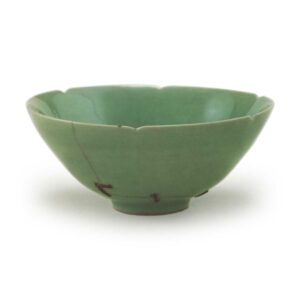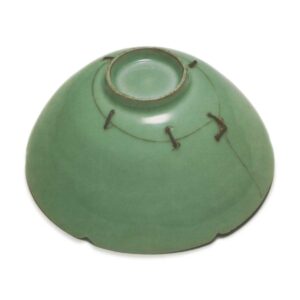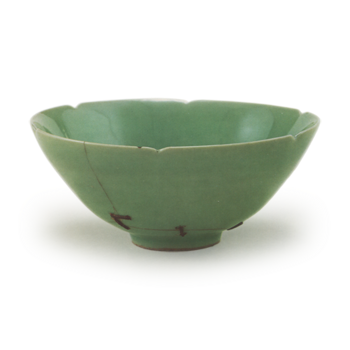

Flying celadon porcelain tea bowl, locust bond
Height: 9.6cm
Mouth diameter: 15.4cm
Outer diameter of stand: 4.5cm
Height: 0.8cm
This is one of the most famous celadon tea bowls in the history of Japan, and its origin is very old. According to the “Bashokubicha Jeungjeungki” written by Ito Togai, which is attached to the bowl, it is said that it was given to Taira Shigemori by Zenji Bosho, the abbot of the time, as a return gift when he donated gold to Ikuo Mountain in Song Dynasty, and was treasured by Ashikaga Yoshimasa. When the tea bowl was sent to Ming China in search of a similar bowl, it was returned with a clamp on the crack, saying that such a masterpiece could not be obtained in China. Tonga explains the origin of the inscription as “以鉄釘六鈴束之絆如馬蝗還覚有趣, 乃号馬蝗絆茶甑” (The tea steamer with a locust bond).
Among the many famous tea bowls, there is only one that is said to have been handed down from the Taira Shigemori period, and although it is somewhat legendary, we cannot deny that it was handed down as a mere legend.
The date of manufacture of the tea bowl is the 12th century, or around the time of Shigemori, and the fact that trade between Japan and the Sung dynasty was prosperous at that time does not rule out Shigemori’s possession of the tea bowl. However, the fact that the history of about 300 years from Shigemori to Yoshimasa is unknown is somewhat weak.
After Yoshimasa, there is no doubt that the tradition was true to its origins.
This is a celadon bowl with a six-petaled incised mouth rim, probably made by the Ryusen Kiln. The celadon glaze is truly beautiful, as it has been handed down over many years, with a slightly darker blue interior and a whitish outer surface. The inner surface is slightly bluish, while the outer surface has some whitish areas.
The base is white, and white underglaze is visible on the rim of the mouth.
There is a crack around the base and a single crack extending from the crack to the mouth rim. This crack was probably caused by pouring boiling water. There is a small dark blue repair on the mouth rim.
By the way, there is one other bowl that is exactly the same as this locust-shaped bowl, which is described in “Chado Shodenshu (Collection of Tea Ceremony Traditions)”,
It is a large celadon bowl with two clamps placed on the outside of the bowl.
It was originally in the possession of Doctor Dosan, but later belonged to Oda Sabugoro. It is assumed that it was handed down from Kyokunaose Dosan to Oda Ariraku.
The inner box is a ground house, with a plain black curved cloth, the pouch is a yellow-ground brocade, and the outer box is a wood-ground tame-nuri, with the words “M locust bond” pasted on the box.
The Yoshida family later became the Kadokura family, and the scroll was handed down from generation to generation, including Ryohi and Soan.
Later, probably around the end of the Edo period or the Meiji period, it was handed down to the Mitsui family in Muromachi, Kyoto, where it has remained to the present day.



